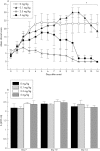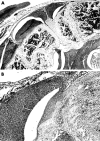Methotrexate ameliorates T cell dependent autoimmune arthritis and encephalomyelitis but not antibody induced or fibroblast induced arthritis
- PMID: 15345503
- PMCID: PMC1755430
- DOI: 10.1136/ard.2004.026120
Methotrexate ameliorates T cell dependent autoimmune arthritis and encephalomyelitis but not antibody induced or fibroblast induced arthritis
Abstract
Objective: To investigate the mode of action of methotrexate (MTX) in different types of models for rheumatoid arthritis (RA) and multiple sclerosis (MS).
Methods: Models for RA and MS were selected known to have different pathogenesis--that is, fibroblast induced arthritis in SCID mice, collagen induced arthritis (CIA), anticollagen II antibody induced arthritis (CAIA), and experimental autoimmune encephalomyelitis (EAE) in (Balb/c x B10.Q)F1 and B10.Q mice, and Pristane induced arthritis in DA rats (PIA). The MTX treatment was started 1 day after the onset of disease and continued for 14 days to compare effects on the different models.
Results: All models known to be critically dependent on T cell activation (CIA, PIA, and EAE) were effectively down regulated by titrated doses of MTX. In contrast, no effects were seen on fibroblast induced arthritis or CAIA. No effects were seen on the levels of anticollagen II antibodies in the CIA experiment.
Conclusion: The data show that MTX has strong ameliorative effect on both classical models of RA, like CIA and PIA, but also on a model for MS, EAE. It also suggests that MTX operates only in diseases which are preceded by, and dependent on, T cell activation. A comparison of CAIA and CIA suggested that MTX operates independently of arthritogenic antibodies. These results demonstrate that different animal models reflect the complexity of the corresponding human diseases and suggest that several models should be used for effective screening of new therapeutic agents.
Figures






Similar articles
-
Therapeutic efficacy of experimental rheumatoid arthritis with low-dose methotrexate by increasing partially CD4+CD25+ Treg cells and inducing Th1 to Th2 shift in both cells and cytokines.Biomed Pharmacother. 2010 Sep;64(7):463-71. doi: 10.1016/j.biopha.2010.01.007. Epub 2010 Feb 25. Biomed Pharmacother. 2010. PMID: 20359858
-
Artemether: a new therapeutic strategy in experimental rheumatoid arthritis.Immunopharmacol Immunotoxicol. 2005;27(4):615-30. doi: 10.1080/08923970500418786. Immunopharmacol Immunotoxicol. 2005. PMID: 16435580
-
Albumin-coupled methotrexate (MTX-HSA) is a new anti-arthritic drug which acts synergistically to MTX.Rheumatology (Oxford). 2004 Sep;43(9):1097-105. doi: 10.1093/rheumatology/keh254. Epub 2004 Jun 15. Rheumatology (Oxford). 2004. PMID: 15199219
-
[Animal models for bone and joint disease. CIA, CAIA model].Clin Calcium. 2011 Feb;21(2):253-9. Clin Calcium. 2011. PMID: 21289422 Review. Japanese.
-
Utility of animal models for identification of potential therapeutics for rheumatoid arthritis.Ann Rheum Dis. 2008 Nov;67(11):1505-15. doi: 10.1136/ard.2007.076430. Epub 2007 Nov 29. Ann Rheum Dis. 2008. PMID: 18055474 Review.
Cited by
-
Immunomodulatory drugs regulate HMGB1 release from activated human monocytes.Mol Med. 2010 Sep-Oct;16(9-10):343-51. doi: 10.2119/molmed.2010.00031. Epub 2010 Apr 9. Mol Med. 2010. PMID: 20386869 Free PMC article.
-
Point mutation of tyrosine 759 of the IL-6 family cytokine receptor, gp130, augments collagen-induced arthritis in DBA/1J mice.BMC Musculoskelet Disord. 2009 Feb 19;10:23. doi: 10.1186/1471-2474-10-23. BMC Musculoskelet Disord. 2009. PMID: 19228423 Free PMC article.
-
Therapeutic effect of dimethyl dimethoxy biphenyl dicarboxylate on collagen-induced arthritis in rats.Chin J Integr Med. 2015 Nov;21(11):846-54. doi: 10.1007/s11655-014-1746-1. Epub 2014 Mar 2. Chin J Integr Med. 2015. PMID: 24584757
-
Periodontal treatment prevents arthritis in mice and methotrexate ameliorates periodontal bone loss.Sci Rep. 2019 May 31;9(1):8128. doi: 10.1038/s41598-019-44512-9. Sci Rep. 2019. PMID: 31148565 Free PMC article.
-
The X-Linked Inhibitor of Apoptosis Protein Inhibitor Embelin Suppresses Inflammation and Bone Erosion in Collagen Antibody Induced Arthritis Mice.Mediators Inflamm. 2015;2015:564042. doi: 10.1155/2015/564042. Epub 2015 Aug 4. Mediators Inflamm. 2015. PMID: 26347311 Free PMC article.
References
Publication types
MeSH terms
Substances
LinkOut - more resources
Full Text Sources
Other Literature Sources
Medical

